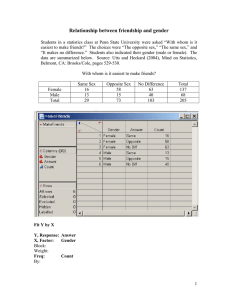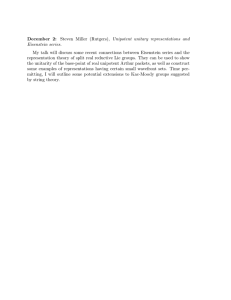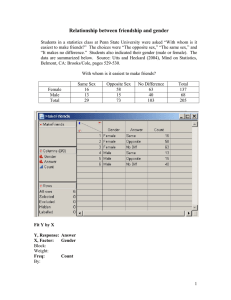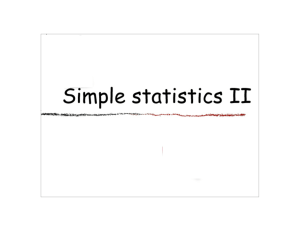Variation and Change in Online Writing Jacob Eisenstein @jacobeisenstein
advertisement
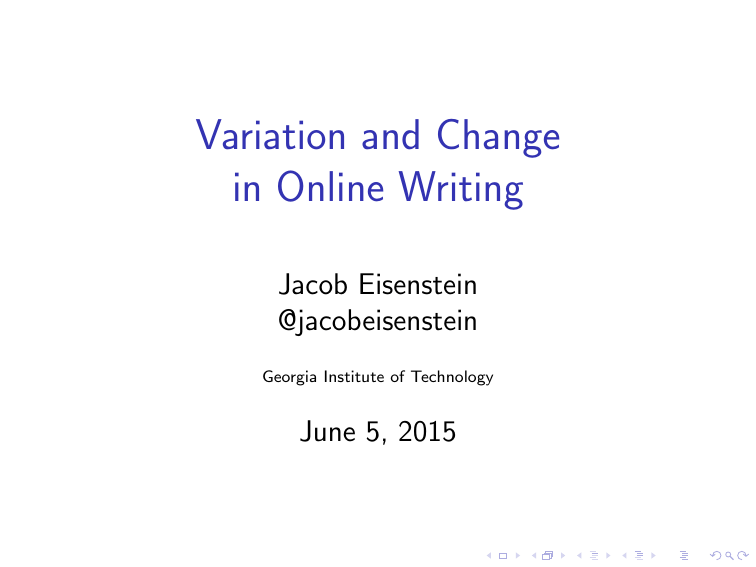
Variation and Change
in Online Writing
Jacob Eisenstein
@jacobeisenstein
Georgia Institute of Technology
June 5, 2015
Social media in NAACL 2015
X Soricut and Och train skipgrams on
Wikipedia.
X Faruqui et al test on IMDB movie
reviews.
7 Krishnan and Eisenstein analyze movie
dialogues
X Tutorial on social media predictive
analysis from Volkova et al.
X Keynote speech by Lillian Lee on
message propagation in Twitter.
Social media in (E)ACL 2014
7 Lei et al train and test on lots of
newstext treebanks
X Devlin et al evaluate on Darpa BOLT
Web Forums
X Plank et al focus on Twitter POS tagging
X Olariu summarizes microblogging streams
Social media in (E)ACL 2014
7 Lei et al train and test on lots of
newstext treebanks
X Devlin et al evaluate on Darpa BOLT
Web Forums
X Plank et al focus on Twitter POS tagging
X Olariu summarizes microblogging streams
Social media won!
Now what?
NLP tools versus social media
I
I
I
Part-of-speech errors
increase by 5x
(Gimpel et al., 2011)
Named entity
recognition accuracy
from 86% to 44%
(Ritter et al., 2011)
Syntactic parsing
accuracy down by
double-digits
(Foster et al., 2011)
Why and what to do?
Some herald the birth of a new “netspeak”
dialect (Thurlow, 2006).
If we build new treebanks for netspeak, will our
problems be solved?
What’s different in social media: who
then a few authors, largely homogeneous
now millions of authors, highly diverse
What’s different in social media: what
then constrained set of topics, focusing on
“what’s fit for print”
now unconstrained content, with emphasis on
phatic communication
What’s different in social media: when
then asynchronous: write it today, read it
tomorrow, few opportunities to respond
now speech-like synchrony in written text
What’s different in social media: how
then professionalized writing process, subject
to strong institutional regulation
now diverse social contexts for writing, largely
free of (traditional) institutional pressures
From netspeak to netspeaks: variation
Social media is not a dialect, genre, or register.
Diversity is one of its most salient properties.
I
hubs blogged bloggers giveaway @klout
I
kidd hubs xo =] xoxoxo muah xoxo darren
I
(: :’) xd (; /: <333 d: <33 </3 -___-
I
nods softly sighs smiles finn laughs
I
lmfaoo niggas ctfu lmfaooo wyd lmaoo
I
gop dems senate unions conservative democrats
I
/cc api ios ui portal developer e3 apple’s
(from Bamman et al., 2014)
From netspeak to netspeaks: change
1.035
As social media takes on a
speech-like role, new
textual affordances are
needed for paralinguistic
with NEs
without NEs
information.
Weaker language
Out-of-vocabulary bigrams
standards encourages
between pairs of 1M-word
experimentation and
samples, divided by base
novelty.
relative proportion of OOV bigrams
I
1.030
1.025
1.020
1.015
1.010
1.005
1.000
I
5
10
month gap
15
20
rate (Eisenstein, 2013b).
Variation and change in social media
I
I
I
Traditional annotation + learning approaches
will not “solve” social media NLP.
Building robust language technology for social
media requires understanding variation and
change.
Sociolinguistics is dedicated to exactly these
issues, but has mainly focused on small speech
corpora. My goal is to apply sociolinguistic
ideas to large-scale social media.
synchronous
A landscape of digital communication
Instant messaging
Tagliamonte and Denis 2008
Chatrooms
Paolillo 1999
Text messages
asynchronous
Ling 2005
Anis 2007
Email
Twitter
Eisenstein et al 2010
Zappavigna 2012
Doyle 2014
Facebook
Baron 1998
Blogs, Forums,
Wikipedia
Herring and Paolillo 2006
Androutsopoulos 2007
Scherrer and Rambow 2010
more private
more public
Twitter
I
I
I
140-character
messages
Each user has a
custom timeline of
people they’ve
chosen to follow.
Most data is publicly
accessible, and social
network and
geographical
metadata is
available.
Who are these people?
(Pew Research Center)
I
% of online adults
who use Twitter;
per-message
statistics will differ.
I
Representativeness
concerns are real,
but there are
potential solutions.
I
Social media has
important
representativeness
advantages too.
Table of Contents
Lexical variation
Orthographic variation
Language change as sociocultural influence
Language change in social networks
Yinz
I
2nd-person
pronoun
I
Western
Pennsylvania
I
Very rare: appears
in 535 of 108
messages
Yall
I
2nd-person
pronoun
I
Southeast,
African-American
English
I
Once per 250
messages
Hella
I
Intensifier, e.g.
i got hella nervous
I
Northern California
(Bucholtz et al.,
2007)
I
Once per 1000
messages
Jawn
I
Noun, diffuse
semantics
I
Philadelphia,
hiphop (Alim,
2009)
I
Once per 1000
messages
I
@user ok u have heard this jawn right
I
i did wear that jawn but it was kinda warm this week
Summary of spoken dialect terms
rate
region
yinz 200, 000 mainly used in Western PA
yall 250
ubiquitous
hella 1000
ubiquitous, but more frequent
in Northern California
jawn 1000
mainly used in Philadelphia
I
I
Overall: mixed evidence for spoken language
dialect variation in Twitter.
But are these the right words?
Measuring regional specificity
Per region r ,
I Difference in frequencies, fi,r − fi
over-emphasizes frequent words
Measuring regional specificity
Per region r ,
I Difference in frequencies, fi,r − fi
over-emphasizes frequent words
I
Log-ratio in frequencies, log fi,r − log fi = log
over-emphasizes rare words
fi,r
fi
Measuring regional specificity
Per region r ,
I Difference in frequencies, fi,r − fi
over-emphasizes frequent words
I
Log-ratio in frequencies, log fi,r − log fi = log
fi,r
fi
over-emphasizes rare words
I
Regularized log-frequency ratio,
ηi,r ≈ log fi,r − log fi , where |ηi,r | is penalized.
η̂r = arg max
η
log P(w |η; f ) − λ|η|
λ controls the tradeoff between rare
and frequent words
Discovered words
I
I
I
I
New York: flatbush, baii, brib, bx, staten,
mta, odee, soho, deadass, werd
Los Angeles: pasadena, venice, anaheim,
dodger , disneyland, angeles, compton, ucla,
dodgers, melrose
Chicago: #chicago, lbvs, chicago,
blackhawks, #bears, #bulls, mfs, cubs, burbs,
bogus
Philadelphia: jawn, ard, #phillies, sixers,
phils, wawa, philadelphia, delaware, philly ,
phillies
place names entities words
ard
alternative spelling for alright
I
I
@name ard let me kno
lol u’ll be ard
lbvs
laughing but very serious
I
I
i wanna rent a hotel room just to swim lbvs
tell ur momma 2 buy me a car lbvs
odee
intensifier, related to overdose or overdone
I
I
I
i’m odee sleepy
she said she odee miss me
its rainin odee :(
Table of Contents
Lexical variation
Orthographic variation
Language change as sociocultural influence
Language change in social networks
Phonologically-motivated variables
-t,-d deletion jus, ol
th-stopping dis, doe
r-lessness togetha, neva, lawd, yaself, shawty
vowels tha (the), mayne (man), bruh, brah
(bro)
relaxed pronunciations prolly, aight
“allegro spellings” (Preston, 1985) gonna, finna,
fitna, bouta, tryna, iono
alternative spelling
rate
gloss
alt. freq
wanna
tryna
wassup
bruh
prolly
doe
na
betta
holla
neva
aight
ta
bouta
shawty
ion
1,078
4,073
8,336
11,423
12,872
13,228
14,354
15,096
15,814
15,898
16,004
17,948
21,301
21,966
26,196
want to
trying to
what’s up
bro
probably
though
no
better
holler
never
alright
to
about to
shorty
i don’t
0.642
0.444
0.499
0.204
0.271
0.149
0.0263
0.0720
0.918
0.0628
0.373
0.00351
0.118
0.601
0.0377
G-deletion
I
In speech, “g” is deleted more often from verbs.
Does this syntactic conditioning transfer to
writing?
G-deletion
I
I
I
In speech, “g” is deleted more often from verbs.
Does this syntactic conditioning transfer to
writing?
Corpus: 120K tokens of top 200 unambiguous
-ing words (ex. king, thing, sing)
Part-of-speech tags from CMU Twitter tagger
(Gimpel et al., 2011).
G-deletion: type-level analysis
0.8
popping
0.7
adjective
verb
noun
chilling
Probability of g-deletion
0.6
0.5
0.4
0.3
0.2
0.1
0.0
rocking
rolling
freaking
jumping
fucking
hating
acting
dropping
talking
saying
laying telling
doing
cutting
getting
hurting cooking calling
feeling
sitting
hanging
nothing
yelling
crying
washing picking
having watching
wakingmoving eating
liking
something
breaking
wearing listening
craving
cleaning reading
morning
closing ending ring wedding
everything
5
6
7
Log word count
8
(Colored by most common POS tag)
9
going
G-deletion: variable rules analysis
Weight
Log odds
%
Verb
Noun
Adjective
.556
.497
.447
.227
-.013
-.213
.200 89,173
.083 18,756
.149 4,964
monosyllable
.071
-2.57
.001
108,804
.178
112,893
Total
N
G-deletion: variable rules analysis
Weight
Log odds
%
Verb
Noun
Adjective
.556
.497
.447
.227
-.013
-.213
.200 89,173
.083 18,756
.149 4,964
monosyllable
.071
-2.57
.001
108,804
@-message
.534
.134
.205
36,974
.178
112,893
Total
N
G-deletion: variable rules analysis
Weight
Log odds
%
Verb
Noun
Adjective
.556
.497
.447
.227
-.013
-.213
.200 89,173
.083 18,756
.149 4,964
monosyllable
.071
-2.57
.001
108,804
@-message
.534
.134
.205
36,974
High Euro-Am county
High Afro-Am county
.452
.536
-.194
.145
.117 28,017
.241 27,022
High pop density county .514
Low pop density county .496
.055
-.017
.228 27,773
.144 28,228
Total
.178
N
112,893
Two broad categories of variables
1. Imported from speech
I
I
I
Lexical variables (jawn, hella)
Phonologically-inspired variation
(-g and -t,-d deletion)
These variables bring traces of their social and
linguistic properties from speech.
2. Endogenous to digital writing
I
I
I
I
Abbreviations (lls, ctfu, asl, ...)
Emoticons (- -)
Why should these vary with geography?
How stable is this form of variation?
Table of Contents
Lexical variation
Orthographic variation
Language change as sociocultural influence
Language change in social networks
Change from 2010-2012: lbvs
tell ur momma 2 buy me a car lbvs
Change from 2009-2012: - flight delayed - - just what i need
Diffusion in social networks
Propagation of a cultural innovation requires:
1. Exposure
2. Decision to adopt it
Why is there geographical variation in netspeak?
Diffusion in social networks
Propagation of a cultural innovation requires:
1. Exposure
2. Decision to adopt it
Why is there geographical variation in netspeak?
I 97% of “strong ties” (mutual @mentions) are
between dyads in the same metro area.
Change from 2009-2012: ctfu
@name lmao! haahhaa ctfu!
The voyage of ctfu
2009
2010
2011
2012
Cleveland
Pittsburgh, Philadelphia
Washington DC, Chicago, NY
San Francisco, Columbus
The voyage of ctfu
2009
2010
2011
2012
I
I
Cleveland
Pittsburgh, Philadelphia
Washington DC, Chicago, NY
San Francisco, Columbus
This trajectory is hard to explain with models
based only on geography or population.
Is there a role for cultural influence? (Labov,
2011)
An aggregate model of lexical diffusion
ctfu
lbvs
- I
Thousands of words have changing frequencies.
I
Each spatiotemporal trajectory is idiosyncratic.
I
What’s the aggregate picture?
Language change as an autoregressive process
Word counts are binned into 200 metro areas and
165 weeks.
η2 ∼ N(Aη1 , Σ)
cctfu,1 ∼ Binomial(f (ηctfu,1 ), N1 )
chella,1 ∼ Binomial(f (ηhella,1 ), N1 )
...
η3 ∼ N(Aη2 , Σ)
cctfu,2 ∼ Binomial(f (ηctfu,2 ), N2 )
chella,2 ∼ Binomial(f (ηhella,2 ), N2 )
...
Estimating parameters of this autoregressive process
reveals geographic pathways of diffusion across
thousands of words (Eisenstein et al., 2014).
Inference
P(words; influence) , P(c; a)
emission transition
=
X
z
X z }| { z }| {
P(c, z; a) =
P(c | z) P(z; a)
z
(z represents “activation”)
Inference
P(words; influence) , P(c; a)
emission transition
=
X
z
X z }| { z }| {
P(c, z; a) =
P(c | z) P(z; a)
z
(z represents “activation”)
Z
=
P(c | z)P(z; a)dz
(uh oh...)
Inference
P(words; influence) , P(c; a)
emission transition
=
X
z
X z }| { z }| {
P(c, z; a) =
P(c | z) P(z; a)
z
(z represents “activation”)
Z
P(c | z)P(z; a)dz
=
(uh oh...)
→ z (k) , k ∈ {1, 2, . . . , K }
X
≈
P(c | z (k) )P(z (k) ; a)
k
(Monte Carlo approximation to the rescue!)
Inference
P(words; influence) , P(c; a)
emission transition
=
X
X z }| { z }| {
P(c, z; a) =
P(c | z) P(z; a)
z
z
(z represents “activation”)
Z
P(c | z)P(z; a)dz
=
(uh oh...)
→ z (k) , k ∈ {1, 2, . . . , K }
X
≈
P(c | z (k) )P(z (k) ; a)
k
(Monte Carlo approximation to the rescue!)
X
â = arg max
P(c | z (k) )P(z (k) ; a)
a
k
0.06
Philadelphia, PA
3
Cleveland, OH
Pittsburgh, PA
2
Youngstown, OH
0.04
1
ηt
ctfu
word frequency
0.05
0.03
0
0.02
−1
0.01
0
−2
50
100
150
50
100
150
50
100
150
50
100
150
100
150
3
0.05
Memphis, TN
2.5
St. Louis, MO
2
Baton Rouge, LA
1.5
0.03
1
ηt
ion
word frequency
0.04
0.5
0.02
0
0.01
0
0.035
0.03
−0.5
−1
50
100
150
1
New York, NY
0.5
Chicago, IL
0
−0.5
0.02
ηt
- -
word frequency
San Francisco, CA
0.025
−1
0.015
−1.5
0.01
−2
0.005
−2.5
0
50
100
150
4
0.035
Philadelphia, PA
Washington, DC
3
Baltimore, MD
2
Atlantic City, NJ
t
0.02
η
ard
word frequency
0.03
0.025
1
0.015
0
0.01
−1
0.005
0
50
100
week
150
50
week
Aggregating region-to-region influence
●
●
●
●
●
●
●
●
●
●
●
●
●
●
●
●
●
●
●
●
●
●
●
●
●
●
●
● ●
●
●
●
●
●
●
●
●
●
●
●
Highly-confident pathways of diffusion
(from autoregressive parameter A).
Possible roles for demographics
I
I
Assortativity: similar cities evolve together.
Influence: certain types of cities tend to lead,
others follow.
Possible roles for demographics
I
I
Assortativity: similar cities evolve together.
Influence: certain types of cities tend to lead,
others follow.
I
I
2010 US Census gives
detailed demographics for
each city.
Are there types of
demographic relationships
that are especially
frequent among linked
cities?
Logistic regression
Cleveland
Location: -81.6, 41.5
Population: 2 million
Median income: 60,200
% Renters: 33,3%
% African American: 21.2%
...
Philadelphia
Location: -75.2, 39.9
Population: 6 million
Median income: 75,700
% Renters: 31.6%
% African American: 22.1%
...
Logistic regression
Link: true
Cleveland
Location: -81.6, 41.5
Population: 2 million
Median income: 60,200
% Renters: 33,3%
% African American: 21.2%
...
Feature vector
Distance: 715 km
Log pop sum: 30.1
Abs diff log median
income: 0.2
Abs diff % renters: 1.7%
Abs diff % Af-Am: 0.9%
...
Raw diff log median
income: -0.2
Raw diff % renters: 1.7%
Raw diff % Af-Am: 0.9%
...
Philadelphia
Location: -75.2, 39.9
Population: 6 million
Median income: 75,700
% Renters: 31.6%
% African American: 22.1%
...
Regression coefficients
Symmetric effects
Negative value means:
links are associated with
greater similarity between
sender/receiver
Asymmetric effects
Positive value means:
links are associated with
sender having a
higher value than receiver
Geo. Distance
Abs Diff, % Urbanized
Abs Diff, Log Med. Income
Abs Diff, Med. Age
Abs Diff, % Renter
Abs Diff, % Af. Am
Abs Diff, % Hispanic
Raw Diff, Log Population
Raw Diff, % Urbanized
Raw Diff, Log Med. Income
Raw Diff, Med. Age
Raw Diff, % Renter
Raw Diff, % Af. Am
Raw Diff, % Hispanic
●
●
●
●
●
●
●
●
●
●
●
●
●
●
−2
I
I
−1
0
−0.956 (0.113)
−0.628 (0.087)
−0.775 (0.108)
−0.109 (0.103)
−0.051 (0.089)
−1.589 (0.099)
−1.314 (0.161)
0.283 (0.057)
0.126 (0.093)
0.154 (0.077)
−0.218 (0.076)
0.005 (0.061)
−0.039 (0.076)
−0.124 (0.099)
1
Assortativity by race (of cities!) even more
important than geography.
Asymmetric effects are weaker, but bigger,
younger metros tend to lead.
Diffusion in social networks
Propagation of a cultural innovation requires:
1. Exposure
2. Decision to adopt it
Why is there geographical variation in netspeak?
I 97% of “strong ties” (mutual @mentions) are
between dyads in the same metro area.
Diffusion in social networks
Propagation of a cultural innovation requires:
1. Exposure
2. Decision to adopt it
Why is there geographical variation in netspeak?
I 97% of “strong ties” (mutual @mentions) are
between dyads in the same metro area.
I Diffusion depends on sociocultural affinity and
influence, not just geography and population.
One more example: ard
lol u’ll be ard
Stable variation
4
0.035
Philadelphia, PA
0.025
Washington, DC
3
Baltimore, MD
2
Atlantic City, NJ
0.02
ηt
ard
word frequency
0.03
0
0.01
−1
0.005
0
50
100
week
I
I
I
1
0.015
150
50
100
150
week
In three years, ard never gets from Baltimore
to DC! (It gets to Philadelphia within a year.)
The connection to spoken variation is tenuous.
So what explains this stability?
Table of Contents
Lexical variation
Orthographic variation
Language change as sociocultural influence
Language change in social networks
From macro to micro
Macro-level variation and change must ground out
in individual linguistic decisions.
I
I
I
With social media data, we can
distinguish the contexts in which
feature counts appear.
One way to define context is by the
intended audience.
Variables that are used for smaller,
more local audiences may be more
persistent.
(Pavalanathan
& Eisenstein,
2015)
Broadcast
Hashtag-initial
Addressed
Logistic regression
I
I
Dependent variable: does the tweet contain a
local word (e.g., lbvs, hella, jawn)
Predictors
I
I
Message type: broadcast, addressed, #-initial
Controls: message length, author statistics
Small audience → less standard language
Local audience → less standard language
Diffusion in social networks
Propagation of a cultural innovation requires:
1. Exposure
2. Decision to adopt it
Why is there geographical variation in netspeak?
I 97% of “strong ties” (mutual @mentions) are
between dyads in the same metro area.
I Diffusion depends on sociocultural affinity and
influence, not just geography and population.
Diffusion in social networks
Propagation of a cultural innovation requires:
1. Exposure
2. Decision to adopt it
Why is there geographical variation in netspeak?
I 97% of “strong ties” (mutual @mentions) are
between dyads in the same metro area.
I Diffusion depends on sociocultural affinity and
influence, not just geography and population.
I Non-standard features are more likely to be
transmitted along strong, local ties.
Summary
I
I
I
I
Social media is transforming written language!
Social media writing is variable and dynamic,
but not noisy: there is always an underlying
sociolinguistic structure.
Recovering this structure promises new insights
for both linguistics and language technology.
Next steps:
I
I
modeling individual linguistic decisions
applying these results to build more robust
language technology
Thanks!
To my collaborators:
I David Bamman (CMU)
I Fernando Diaz (MSR)
I Naman Goyal (Georgia Tech)
I Brendan O’Connor (UMass)
I Ioannis Paparrizos (Columbia)
I Umashanthi Pavalanathan (Georgia Tech)
I Tyler Schnoebelen (Stanford and Idibon)
I Noah A. Smith (University of Washington)
I Hanna Wallach (MSR and UMass)
I Eric P. Xing (CMU)
And to the National Science Foundation.
Alim, H. S. (2009). Hip hop nation language. In A. Duranti (Ed.), Linguistic Anthropology: A Reader (pp.
272–289). Malden, MA: Wiley-Blackwell.
Anis, J. (2007). Neography: Unconventional spelling in French SMS text messages. In B. Danet & S. C. Herring
(Eds.), The Multilingual Internet: Language, Culture, and Communication Online (pp. 87–115). Oxford
University Press.
Bamman, D., Eisenstein, J., & Schnoebelen, T. (2014). Gender identity and lexical variation in social media.
Journal of Sociolinguistics, 18 (2), 135–160.
Bucholtz, M., Bermudez, N., Fung, V., Edwards, L., & Vargas, R. (2007). Hella nor cal or totally so cal? the
perceptual dialectology of california. Journal of English Linguistics, 35 (4), 325–352.
Doyle, G. (2014). Mapping dialectal variation by querying social media. In Proceedings of the European Chapter of
the Association for Computational Linguistics (EACL), (pp. 98–106)., Stroudsburg, Pennsylvania. Association
for Computational Linguistics.
Eisenstein, J. (2013a). Phonological factors in social media writing. In Proceedings of the Workshop on Language
Analysis in Social Media, (pp. 11–19)., Atlanta.
Eisenstein, J. (2013b). What to do about bad language on the internet. In Proceedings of the North American
Chapter of the Association for Computational Linguistics (NAACL), (pp. 359–369)., Stroudsburg,
Pennsylvania. Association for Computational Linguistics.
Eisenstein, J. (2015a). Systematic patterning in phonologically-motivated orthographic variation. Journal of
Sociolinguistics, 19, 161–188.
Eisenstein, J. (2015b). Written dialect variation in online social media. In C. Boberg, J. Nerbonne, & D. Watt
(Eds.), Handbook of Dialectology. Wiley.
Eisenstein, J., Ahmed, A., & Xing, E. P. (2011). Sparse additive generative models of text. In Proceedings of the
International Conference on Machine Learning (ICML), (pp. 1041–1048)., Seattle, WA.
Eisenstein, J., O’Connor, B., Smith, N. A., & Xing, E. P. (2010). A latent variable model for geographic lexical
variation. In Proceedings of Empirical Methods for Natural Language Processing (EMNLP), (pp.
1277–1287)., Stroudsburg, Pennsylvania. Association for Computational Linguistics.
Eisenstein, J., O’Connor, B., Smith, N. A., & Xing, E. P. (2014). Diffusion of lexical change in social media. PLoS
ONE, 9.
Gimpel, K., Schneider, N., O’Connor, B., Das, D., Mills, D., Eisenstein, J., Heilman, M., Yogatama, D., Flanigan,
J., & Smith, N. A. (2011). Part-of-speech tagging for Twitter: annotation, features, and experiments. In
Proceedings of the Association for Computational Linguistics (ACL), (pp. 42–47)., Portland, OR.
Herring, S. C. & Paolillo, J. C. (2006). Gender and genre variation in weblogs. Journal of Sociolinguistics, 10 (4),
439–459.
Huberman, B., Romero, D. M., & Wu, F. (2008). Social networks that matter: Twitter under the microscope.
First Monday, 14 (1).
Labov, W. (2011). Principles of Linguistic Change, volume 3: Cognitive and Cultural Factors. Wiley-Blackwell.
Paolillo, J. C. (1999). The virtual speech community: Social network and language variation on irc. J.
Computer-Mediated Communication, 4 (4), 0.
Pavalanathan, U. & Eisenstein, J. (2015). Audience-modulated variation in online social media. American Speech,
(in press).
Preston, D. R. (1985). The Li’l Abner syndrome: Written Representations of Speech. American Speech, 60 (4),
328–336.
Tagliamonte, S. A. & Denis, D. (2008). Linguistic ruin? LOL! Instant messaging and teen language. American
Speech, 83 (1), 3–34.
Takhteyev, Y., Gruzd, A., & Wellman, B. (2012). Geography of twitter networks. Social networks, 34 (1), 73–81.
Thurlow, C. (2006). From statistical panic to moral panic: The metadiscursive construction and popular
exaggeration of new media language in the print media. Journal of Computer-Mediated Communication,
667–701.
More mentions by users in same metro area
Local audience → less standard language
Messages containing
local variable
Messages not
containing local
variable
More mentions by users in other metro areas
Why raw word counts won’t work
We observe counts cw ,r ,t for word w in region r at
time t. How does cw ,r ,t influence cw ,r 0 ,t+1 ?
I
Both word counts and city sizes follow power law
distributions, with lots of zero counts.
I
Exogenous events such as pop culture and weather
introduce global temporal effects.
Twitter’s sampling rate is inconsistent, both spatially
and temporally.
I
Latent activation model
cw ,r ,t ∼Binomial(βw ,r ,t , sr ,t )
Latent activation model
cw ,r ,t ∼Binomial(βw ,r ,t , sr ,t )
βw ,r ,t = Logistic(νw ,t + µr ,t + ηw ,r ,t )
Latent activation model
cw ,r ,t ∼Binomial(βw ,r ,t , sr ,t )
βw ,r ,t = Logistic(νw ,t + µr ,t + ηw ,r ,t )
I
νwt
Base word log-probability
Latent activation model
cw ,r ,t ∼Binomial(βw ,r ,t , sr ,t )
βw ,r ,t = Logistic(νw ,t + µr ,t + ηw ,r ,t )
νwt
νwt+μrt
I
Base word log-probability
I
City-specific “verbosity”
Latent activation model
cw ,r ,t ∼Binomial(βw ,r ,t , sr ,t )
βw ,r ,t = Logistic(νw ,t + µr ,t + ηw ,r ,t )
νwt
νwt+μrt
νwt+μrt+ηwrt
I
Base word log-probability
I
City-specific “verbosity”
I
Spatio-temporal
activation
Dynamics model
cw ,r ,t ∼Binomial(βw ,r ,t , sr ,t )
βw ,r ,t =Logistic(νw ,t + µr ,t + ηw ,r ,t )
X
ηw ,r ,t ∼Normal(
ar 0 →r ηw ,r 0 ,t−1 , γw ,r )
r0
I
I
I
ai→j captures the linguistic “influence” of city i
on city j.
If ηj,t+1 = ηi,t , then ai→j = 1, and ai→j = 0.
If ηj and ηi co-evolve smoothly, then ai,j > 0
and aj,i > 0.
